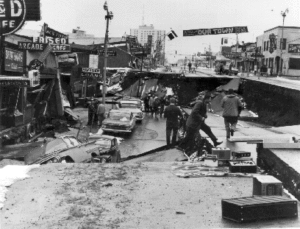Ask Anchorage after last Friday’s 7.0 earthquake. Admittedly, this is not the biggest earthquake the area could have suffered. The famous 1964 earthquake registered at 9.2, triggered a tsunami, and killed an estimated 130 people. Still, by and large, things seemed to work as planned.
Ask the mayor. And the governor. Mayor Ethan Berkowitz says building codes and good preparation minimized structural damages. No one died. Berkowitz even stated to PBS that other cities would want to emulate Anchorage “because Anchorage did this right.” Alaska Governor Bill Walker admitted to sometimes grousing about strict building codes but conceded, “Building codes mean something,” stating that his own home suffered only minor water damage.
What worked? According to the same PBS report, “Sterling Strait, a member of the Alaska Seismic Hazards Safety Commission, said the states [Alaska and California] use the International Building Code,” which he deemed the “best available standard for seismic safety.”
This good news comes while some states and jurisdictions, in some parts of the country, still resist more stringent building codes, and when some voters still resent what they view as an imposition, sometimes even after the damage from a hurricane, flood, wildfire, or earthquake. But the higher standards matter in saving lives and preventing building collapse, which also prevents injuries. Tellingly, Anchorage hospitals reported a normal day, with no dramatic upsurge in injuries from the earthquake.
One factor working in Anchorage’s favor is its relative newness as a big city, now about 300,000 population. A city of only 3,000 as late as 1940, Anchorage grew rapidly during and after World War II, still claiming only about 100,000 at the time of the 1964 earthquake. The salient result is that, between its late start as an urban center and the destruction of many older buildings in 1964, Anchorage has far fewer legacy buildings predating modern seismic construction standards than some other cities in states like California. Many California cities, including Los Angeles and Berkeley, have spent considerable sums to subsidize seismic retrofits for older structures including highly vulnerable unreinforced masonry buildings.
As an urban planner, my own expertise lies with land use and not structural engineering, so I will not elaborate on the details of building codes as if I were an expert, but the evidence is compelling. I will note one handout I found on the Anchorage city website, however, on geotechnical investigations. It concerns a requirement for a report from a geotechnical expert and inspection requirements for structures in what are known as Hazard Zones 4 and 5, which define high levels of geological susceptibility to ground failure as result of seismic shaking. The applicable handout dates to 2006, and references a June 1989 report by Shannon & Wilson, a Seattle-based engineering firm. Those dates indicate that Anchorage has been steadily at work on this problem ever since the 1964 earthquake, not wishing to repeat or continue the vulnerabilities exposed by that event.
Without delving into technical details, the bottom line is that, in the designated areas, a civil engineer with experience in geotechnical engineering must perform an investigation of the potential extent of ground movements and soil loadings on the structure proposed, and must prepare and sign a written report showing calculations, conclusions, and recommendations for how the building will be able to withstand seismic displacements without collapsing. The work must then be performed in accordance with those recommendations, and the engineer must ensure compliance through special inspections and a signed statement that his design was followed.
This approach is hardly new but is also far from universal. I learned a good deal about it in the context of municipal requirements in Utah cities around 2005 in the process of completing production of a Planning Advisory Service Report, Landslide Hazards and Planning, by the American Planning Association, with support from the U.S. Geological Survey. Such surveys cost money, but so does wanton damage from a failure to comply.
Alaska did experience problems, but not primarily with buildings. It is still far too early for a complete survey of the damage suffered by the transportation system, and the city and state need to assess the losses due to highway collapses, structural stresses on bridges, and the like. Currently, a railroad between Anchorage and Fairbanks is not functioning. There are always challenges, and every disaster is an opportunity for reassessments and lessons learned. But one clear lesson has already emerged: Building codes matter.
Jim Schwab
